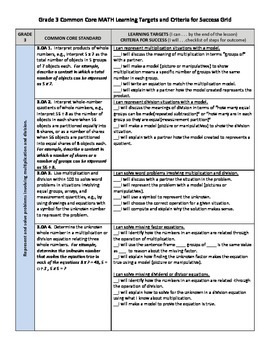Grade 3 Math Common Core Learning Targets and Success Criteria
Abbysolutely Math
84 Followers
Grade Levels
3rd
Subjects
Resource Type
Standards
CCSS3.MD.A.1
CCSS3.MD.A.2
CCSS3.MD.B.3
CCSS3.MD.B.4
CCSS3.MD.C.5
Formats Included
- PDF
Pages
8 pages
Abbysolutely Math
84 Followers
Description
The past 4 years, I've been district hired math coach for the largest school system in NC. I've already decomposed each math standard in the Common Core Math for Grade 3 into kid-friendly language "I can" learning targets complete with "I will" criteria for success. They are organized by each domain and separated by clusters.
These aren't your ordinary "I can" statements you see everywhere because this document will actually help you teach the standard to your students. These are unique because the each standard is built with SIOP in mind and the criteria is research based. Each set of criteria is embedded with the math practice standards so students are learning the content through the practices in order to be more proficient mathematicians in grade 3!
These aren't your ordinary "I can" statements you see everywhere because this document will actually help you teach the standard to your students. These are unique because the each standard is built with SIOP in mind and the criteria is research based. Each set of criteria is embedded with the math practice standards so students are learning the content through the practices in order to be more proficient mathematicians in grade 3!
Total Pages
8 pages
Answer Key
N/A
Teaching Duration
1 Year
Last updated Feb 27th, 2014
Report this resource to TPT
Reported resources will be reviewed by our team. Report this resource to let us know if this resource violates TPT’s content guidelines.
Standards
to see state-specific standards (only available in the US).
CCSS3.MD.A.1
Tell and write time to the nearest minute and measure time intervals in minutes. Solve word problems involving addition and subtraction of time intervals in minutes, e.g., by representing the problem on a number line diagram.
CCSS3.MD.A.2
Measure and estimate liquid volumes and masses of objects using standard units of grams (g), kilograms (kg), and liters (l). Add, subtract, multiply, or divide to solve one-step word problems involving masses or volumes that are given in the same units, e.g., by using drawings (such as a beaker with a measurement scale) to represent the problem.
CCSS3.MD.B.3
Draw a scaled picture graph and a scaled bar graph to represent a data set with several categories. Solve one- and two-step “how many more” and “how many less” problems using information presented in scaled bar graphs. For example, draw a bar graph in which each square in the bar graph might represent 5 pets.
CCSS3.MD.B.4
Generate measurement data by measuring lengths using rulers marked with halves and fourths of an inch. Show the data by making a line plot, where the horizontal scale is marked off in appropriate units-whole numbers, halves, or quarters.
CCSS3.MD.C.5
Recognize area as an attribute of plane figures and understand concepts of area measurement.



